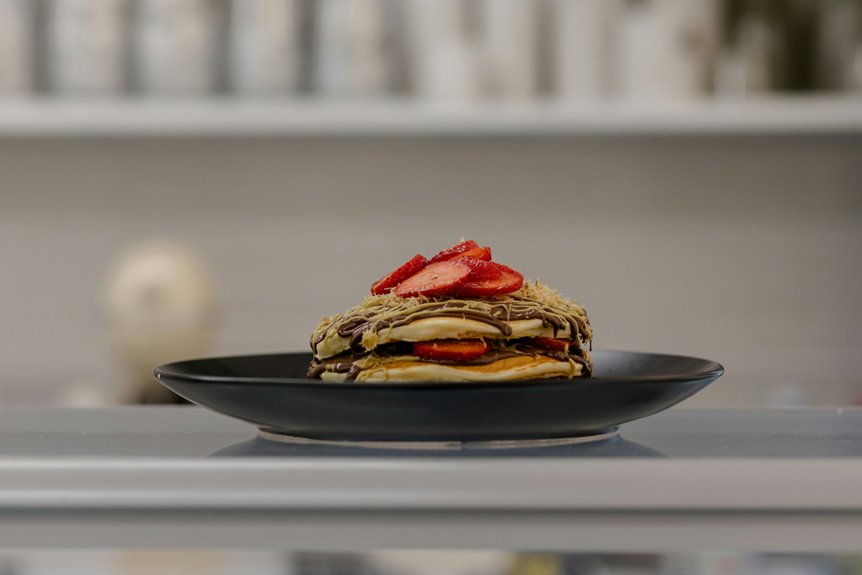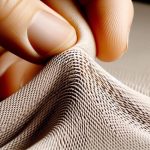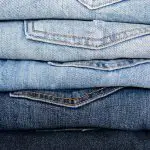Viscose or rayon crepe is a soft, drapey fabric made from wood pulp, designed to mimic silk’s elegance with a unique crinkled texture. You’ll appreciate its graceful flow and natural stretch, perfect for stylish, comfortable wear. While it requires careful production to stay eco-friendly, advances like closed-loop systems reduce its environmental footprint. If you want to explore how to style, care for, and compare this fabric with other sustainable textiles, there’s plenty more to discover.
Table of Contents
Key Takeaways
- Viscose crepe is a type of rayon fabric with a crinkled surface, offering a soft, flowing drape ideal for elegant garments.
- It is made from wood pulp through the viscose process, which chemically treats cellulose to create a silky, breathable texture.
- Viscose crepe combines natural elasticity and a slightly rough feel, enhancing comfort and movement in clothing.
- Sustainable viscose production involves responsible forestry and closed-loop chemical recycling to reduce environmental impact.
- Compared to other eco-friendly fabrics, viscose crepe offers superior softness and fluidity, making it a stylish and sustainable choice.
Understanding the Origins of Viscose and Rayon
Although you may have heard the terms viscose and rayon used interchangeably, understanding their origins reveals important differences.
When you look back, rayon was the first regenerated fiber created to mimic silk, developed in the late 19th century from cellulose sources like wood pulp.
Viscose, on the other hand, is actually a specific type of rayon produced through the viscose process, which involves chemically treating cellulose to create a soluble compound before regenerating it into fibers.
Viscose is a specific rayon made by chemically transforming cellulose into fibers through the viscose process.
So, while all viscose is rayon, not all rayon is viscose—there are other rayon types like modal and lyocell with different production methods.
Knowing this helps you appreciate the fabric’s heritage and why viscose has distinct qualities compared to other rayons, especially regarding texture and drape.
Characteristics That Define Crepe Fabric
Crepe fabric stands out for its distinctive textured surface, marked by a crinkled or pebbled appearance that gives it unique visual and tactile appeal. When you work with crepe, you’ll notice its graceful drape and slightly rough feel, which sets it apart from smoother fabrics. Its texture results from tightly twisted yarns or specific weaving techniques, adding depth and dimension. Plus, crepe’s natural elasticity offers comfort and ease of movement, making it perfect for flowing garments.
| Characteristic | Description |
|---|---|
| Texture | Crinkled or pebbled surface |
| Drape | Soft, fluid, and elegant |
| Yarn Twist | High twist for texture |
| Elasticity | Slight stretch for comfort |
These traits define crepe’s charm and versatility.
The Environmental Impact of Viscose/Rayon Production
While the textured beauty and comfort of viscose/rayon crepe make it a popular choice, it’s important to contemplate how its production affects the environment.
You should know that viscose is derived from wood pulp, often sourced from fast-growing trees like eucalyptus or bamboo. However, the process requires significant water, energy, and chemicals, which can lead to pollution if not managed responsibly.
You might be concerned about deforestation, as unsustainable logging threatens biodiversity and contributes to carbon emissions. Additionally, the chemical treatment releases toxins harmful to both workers and surrounding ecosystems.
That said, some manufacturers now adopt closed-loop systems, recycling chemicals and minimizing waste.
When choosing viscose crepe, look for certifications or brands committed to sustainable, eco-friendly production to reduce your environmental footprint.
Styling and Care Tips for Viscose/Rayon Crepe
When you wear viscose/rayon crepe, you’ll appreciate its lightweight feel and elegant drape, but proper styling and care are key to keeping it looking its best.
To style it, pair this fabric with tailored pieces or soft knits for a balanced look. Its fluid texture complements both casual and formal outfits effortlessly. Avoid bulky accessories that might overshadow its delicate texture.
Pair viscose crepe with tailored or soft knits and keep accessories minimal to highlight its delicate texture.
For care, always check the garment label first. Generally, hand wash or use a gentle machine cycle with cold water to prevent shrinking or distortion. Avoid bleach and harsh detergents.
Hang or lay flat to dry, steering clear of direct sunlight to preserve color. If ironing is needed, use a low heat setting and iron inside out to protect the fabric’s surface. Following these tips helps maintain viscose/rayon crepe’s softness and shape.
Comparing Viscose/Rayon Crepe With Other Sustainable Fabrics
Although viscose/rayon crepe offers a luxurious feel and graceful drape, you might wonder how it stacks up against other sustainable fabrics.
Compared to organic cotton, viscose crepe feels softer and flows better but may require more careful care.
Linen is breathable and eco-friendly but tends to wrinkle easily, unlike crepe’s elegant texture.
Tencel, another sustainable option, shares viscose’s smoothness but often boasts better moisture-wicking properties.
Hemp is durable and low-impact but feels coarser than crepe.
If you want a fabric that balances sustainability with a silky hand and beautiful movement, viscose/rayon crepe is a strong choice.
Just remember to check the source and production methods to verify it meets your sustainability standards.
Frequently Asked Questions
Can Viscose/Rayon Crepe Be Used for Upholstery or Home Décor?
When it comes to upholstery or home décor, you’ll want to think twice about viscose/rayon crepe—it’s not the toughest cookie. It drapes beautifully but might wear out quickly with heavy use.
Is Viscose/Rayon Crepe Suitable for Allergy-Sensitive Skin?
You might find viscose/rayon crepe gentle on allergy-sensitive skin since it’s smooth and breathable. However, always test a small patch first, as individual reactions vary. It’s not hypoallergenic but often tolerable for many.
How Does Viscose/Rayon Crepe Behave in Extreme Weather Conditions?
Viscose crepe absorbs up to 30% of its weight in moisture, so you’ll stay cool in heat but might feel clammy in humidity. In cold weather, it’s less insulating, so layering’s a smart move for comfort.
What Is the Typical Price Range for Viscose/Rayon Crepe Fabric?
You’ll usually find viscose/rayon crepe priced between $8 and $20 per yard, depending on quality and origin. It’s affordable, making it a great choice if you want stylish, breathable fabric without breaking the bank.
Are There Any Notable Designers Known for Using Viscose/Rayon Crepe?
When it comes to viscose crepe, you’ll find designers like Stella McCartney and Diane von Fürstenberg weaving it into their collections. They know how to make fabric sing, blending sustainability with style effortlessly.
- Where to Buy Sherpa Suede Fabric - July 12, 2025
- How to Draw or Illustrate the Texture of Suede Fabric - July 12, 2025
- What Is Baseball Suede Leather Fabric? - July 12, 2025






